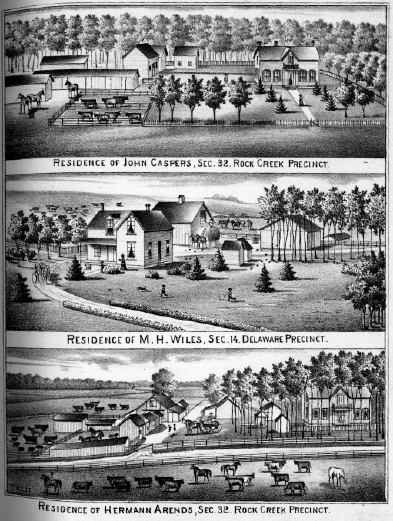part of the army under Sheridan. He
was mustered in at Chambersburg, and from there went
to Washington and took part in nearly every one of the
larger battles of the campaign, besides doing duty in
reconnoitering and skirmishing. He was mustered out
and discharged at Alexandria, June 9, 1865, after a
service of nine months, in which time he had fought in
many of the important battles of the war. Upon leaving
the military service our subject went back to
Pennsylvania, and worked in a foundry until 1867; he
then repaired to Chicago, Ill,, and thence to Iowa
City. continuing at work in various foundries in these
places until 1877, when he came to this State and
settled in Russell Precinct, purchasing eighty acres
of land on section 12. This he at once began to
improve, and succeeded in his labors beyond his
expectations.
Finally, in 1884, receiving what he
believed to be an advantageous offer for his farm, our
subject traded it for his present property, and moved
onto it. The house, barns, groves, orchard, and in
fact all the improvements, have been made since that
time, Mr. Peterson having prospered greatly. He is an
esteemed member of the community, a consistent
adherent of the Lutheran Church, and active in the
ranks of the Democratic party, the principles of which
he has defended since becoming a citizen of this
Republic.
It is gratifying to note the results
of a persistent industry, and the view which is shown
of the Peterson homestead, perhaps, is the most
forcible illustration of this which could be
presented. It forms a reminder which will stand for
years to come and do him honor.

 HOMAS
DEWEY, the owner of 240 acres of fine farming land on
section 32 in Palmyra Precinct, is a very intelligent
English gentleman of good education, who seldom meets
his equal in matters of history and general practical
information. Among his many excellent qualities is the
careful attention which he gives to the education of
his children and his strong advocacy of temperance, he
being a pronounced Prohibitionist. A native of
Dorsetshire, England, our subject was born March 25,
1819, and is a son of George and Margaret (White)
Dewey, who were also of English birth and parentage,
and the father a local politician of considerable
note, holding the office of High Constable, Court
Bailiff, etc. He lived to be seventy years of age,
and, with his excellent wife spent his entire life
upon his native soil. The father survived his wife,
she being seventy-three years old at the time of her
death. Their family consisted of two sons only,
Charles W., and Thomas, our subject. The former is now
deceased. HOMAS
DEWEY, the owner of 240 acres of fine farming land on
section 32 in Palmyra Precinct, is a very intelligent
English gentleman of good education, who seldom meets
his equal in matters of history and general practical
information. Among his many excellent qualities is the
careful attention which he gives to the education of
his children and his strong advocacy of temperance, he
being a pronounced Prohibitionist. A native of
Dorsetshire, England, our subject was born March 25,
1819, and is a son of George and Margaret (White)
Dewey, who were also of English birth and parentage,
and the father a local politician of considerable
note, holding the office of High Constable, Court
Bailiff, etc. He lived to be seventy years of age,
and, with his excellent wife spent his entire life
upon his native soil. The father survived his wife,
she being seventy-three years old at the time of her
death. Their family consisted of two sons only,
Charles W., and Thomas, our subject. The former is now
deceased.
Young Dewey grew up amid the quiet
scenes of country life, and at the age of twenty years
commenced to learn the trades of carpenter and
wheelright. These he pursued in the cities of Lynn,
Southampton, Portsmouth, Brighton, Sussex, Seaford and
other places. He developed rare genius as a machinist,
and in due time was given a position in the civil
engineering department of the Government.
Mr. Dewey when twenty-nine years of
age was married, March 4, 1848, to Miss Mary Ann
Howell, who was born in Sussex, Sept. 17, 1830, and
whose grandfather was a native of Wales. She was the
eldest of four children and the daughter of Richard
and Mary (Elphick) Howell, who were natives of
England, and spent their last years there. Their
family consisted of seven children, four now
living.
Our subject and his wife began the
journey of life together in the city of Lewis,
England, where they lived until after the birth of
four children. Mr. Dewey then decided to seek his
fortune on another continent, and with his little
family set sail from Liverpool on the 1st of May,
1867. Soon after landing upon American soil he made
his way directly across the Mississippi to the newly
admitted State of Nebraska, and bought 160 acres of
land in Hendricks Township. Two years later he
homesteaded eighty acres of his present farm, upon
which he has lived now for a period of nineteen years.
The household circle after the emigration to America
was enlarged by the birth of one more child. George,
the eldest son, when about twenty-eight years old,
went to Montana, and was murdered by the Indians;
Margaret is married; Charles died in England at the
age of six years; Annie is married; Thomas, a bright
and promising youth, is a
|


